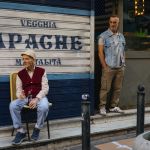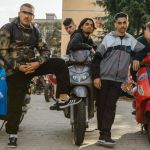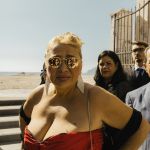
Dress like "Ultras"
We asked how ultras dress in to 2020 to Antonella Mignogna, costume designer of last Netflix success
April 1st, 2020
Glauco Canalis
Ultras' culture is a composition of values, ideas, rituals and images and sounds. Many argue that this is the last contemporary subculture that has survived the evolution of mainstream culture, both in soccer and in sport.
Like any subculture, the visual aspect is one of the fundamental elements, the image of the ultras also regards fashion: from the casual British style to the new streetwear trends, the terraces' fashion is perhaps undervalued in its style and originality. To understand what today symbolizes the fashion of the Italian soccer fans, nss sports had a chat with Antonella Mignogna, who curated all the costumes of ''Ultras', the first film by Francesco Lettieri, released on Netflix last March 20 on Netflix.

In Ultras there are three different generations of fans and ways of understanding fashion.
Who were you inspired by the look of each of the three groups?
From the beginning, in imagining the identities of the various groups with Francesco, we said to try to immediately make from the visual point of view the differences of the three different groups and also of the individual characters who participated in the story. When we started thinking about the Apaches, Francesco came to me with a fanzine of the Napoli ultràs of the early 90s. We had images of walls of people dressed in this denim with super light wash and at that moment, in our mind, was born Sandro who (to make it more aggressive) made his own that stemmed from the model of a vintage jacket, nowhere to be found, of the period of I've always been in love with. During my visual research, through the almost untraceable photos of the time, it turned out that at that time, in the stands of the Napoli fans (which seemed to me a kind of cleaned and much more honest paninari) was not so respected a dress code that only later became (although perhaps in Europe and especially in England already was) of the world ultras. I realized that each of the people I saw in those images, in his own way, was a character in itself that came out of the homogeneity that is one of the peculiarities of casual culture. And that's how we represented the initial team of the apaches, "the distrusted". Each of the characters in the group of founders had their own characteristics that communicated quite clearly, being a film of great corality, its own personality.
I have always tried to talk to the viewer about the characters and the inner worlds that represent them through the nuances that embody their dress codes; I did it with the characters of the video clips before and even more carefully in this movie. The differences that characterize each of them, at a closer look, come to the eye in the many details of their costumes.
A different story for NNN who are, each in their own way, the emblems of what still today embodies the cornerstones of the ultras subculture clothing. For their group I tried to differentiate, through the costumes, the degrees and positions that each character assumes during the story.
For Angelo's group of friends, it was enough to use the usual method that I often resort to in these cases: to look around and re-propose reality, adding here and there an enhanced nuance for visual and personal fun. The children undergo an important metamorphosis of the look as the climax of the film grows and it becomes more and more real their willingness to amalgamate with the NNN group: hair and colors disappear, which are uniformed into that black in which identities disappear and The technical battlewear appears. Many of the characters are similar to the actors who represent them, I have only accented the characteristics that make them special already naturally in the visual dimension. For example the Saitov twins who are ethnic Sinti, O'merican, Michelone, the Dwarf, just look at them, know them and talk to us for a moment and they practically did all the work for you.
How would you summarize the fashion of the ultras in 2020?
Fashion in the ultras world today is made up of unity and security given by the dress code in which the members recognize themselves in an almost obsessive way, as if, in this historical period, the sharing of attachment goes beyond everything else.
Probably because this code has a strong meaning of connection with the roots of the movement that represents to all intents and purposes one of the few subcultures that have survived to date. I like to compare the ultras to a tribe that, even at a distance, through the way of dressing is recognized by each other as an integral part of a world and a unique thought in the various countries. In this perspective, the ultras stadium fashion is certainly technical, monochromatic and understated, while that of leisure, which for them is equally important, is declined in a more frivolous way adding some color from time to time.
What are the brands most used by ultras in stadiums?
Being a fanatic of English casual culture, I splashed very happily in the deepening of research and in selecting all the brands chosen by the movement that represented the ultras in the common imagination. Brands, oddly enough, are a very important part of this aesthetic, as if they embodied the historical codes and meanings of the movement. If I close my eyes I imagine adidas, Fred Perry, Stone Island and Burberry, all of them, passing through Ben Sherman, Aquascutum, Lyle & Scott, Umbro, Lacoste. In recent years The North Face and Alpha Industries have returned to the limelight and are super-listed, but let's not forget the Italian excellences such as Diadora, Ellesse, Sergio Tacchini, C.P. Company. Today, even direct children of the aesthetics of this movement such as the English Weekend Offender or the very young Ma.strum who have a fair amount of success among the adepts of the genre begin to arouse a fair amount of interest.
Do you think stadium fashion still plays a key role in cheering culture?
I think that if we look at soccer fans as a whole the fashion phenomenon is not a widespread interest, but that it has a great value in the ultras environment in which it becomes both recognition and flag.
In the last year this type of aesthetic has also had a strong development of interest outside the groups, taking the attention of lovers of streetwear and normies who reproduce historical elements making them a trend even outside the circle of followers of the casual style. There is, however, and it's super fascinating that there is still, the lover of the stadium mentality, who even in real life dresses in that way to show relationship and love towards that creed. I am convinced that, even today, some elements embody as well as a perfect functionality, also a certain way of life, both for the nostalgic who deepen and for the newbies who approach this culture.
How did you do the research? Did you go to the stadium?
I immersed myself in this culture for a whole month before starting the preparation of the film. I started my research by talking to as many people as possible, of different age groups, both belonging to the movement itself and sympathizers of it. I read essays and consulted visual books. All tips passed me by lovers and scholars of this world who have described to me with great detail the parable of the evolution of style and its various ramifications over time. But the thing I've done the most, and I'm not even a little ashamed of it, is spending hours and hours on Instagram stalking the endless dedicated profiles. There are really a billion of them, some so monothematic to focus on a single element of the dress code such as pages dedicated exclusively to sneaker models and the most infinite variants of colors possible and the most release nowhere to be found. I spent a lot of time viewing not only the pages of both looks and thinking of the various Italian and European groups (which have practically served me on a silver plate references for moodboards thanks to the methodicalness and maniacality with which they are cared for), but above all the private profiles of the users, to which I have risen from the comments, to find out how and how much all that super saturated aesthetic was then declined in everyday life. It was at that moment that I realized that an ultras never ceases to be such, regardless of the work or role it plays in life, throwing signals through a code in the clothing that to the careful eye declares "belonging" even at a distance.
I attended the stadium and the stands only in Naples and in a single period of my life: the one when Napoli played in Serie C (I was still in high school) and I went to Turn A with two friends most Sundays. There were very few diehards around me, but so much true heart. The images of that period remained in my eyes and I hid the details in the imagination that I gave to the various groups from that of the distrusted up to the figures and appearances of the mass scenes of the clashes and the stadium.
Which movies or magazines did you use as a reference?
Many fanzine and searches for rare images and video clips of the away groups and at the stadium, especially private ones. Beyond E.A.M - Strangers to the mass I saw for the first time in that period under the advice of Fra (Francesco Lettieri, n.d.r). By choice and to define the artistic approach to this work, I chose not to review, before starting the design and subsequent choices for the film, the illustrious films of the genre. I preferred to watch as many documentaries as possible on the web also to understand the international appeal of the looks and to have a more realistic approach that I could on today's culture and differences than in the past. I want to mention among all the series "The real football factories" that I found really very interesting. Among the readings recommended to me and which I recommend in turn to understand the thought and genesis of philosophy ultras, deserve the books: "The rebels of the stadiums" by Pierluigi Spagnoli and, in a broader sense on the youth conflict that manifests itself in subcultures, "The syndrome by Andy Capp" by Valerio Marchi. Visually, one of my favorites of the period was Gavin Watson's 2008 "Skins."
One of the cornerstones of the ultras subculture is nonconformism. How do you reconcile this value with the fact that aesthetically the ultras have a very homogeneous style between teams and different countries?
I believe that a first response is to be sought in the desire for immediate recognition and in the manifestation of belonging to the group attested through the unique style on the outside, although this characteristic belongs to many if not all movements subcultural, especially youth. The second variable can be identified in the actual decoding of what is today the ultras style starting from its genesis. I am convinced that casual, by its own definition of birth, wants to approve the style of the middle class of society in order to better identify with it. On this basis, the style has then become "divided" so much as to allow, at the same time, both depersonalization and the identification of a status: the "declaration" of being both an intrinsic part of society and the manifestation of a movement that navigates to the edges of it. And it translated into the way you define yourself discreetly. Starting from this concept the bargained look has then become part of their visual and conceptual universe resulting in international diffusion.








































.png)


.jpg)














































































